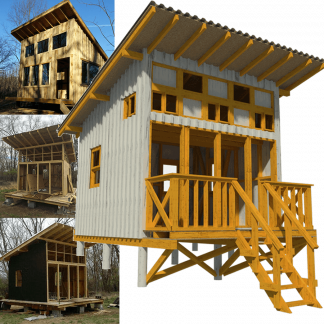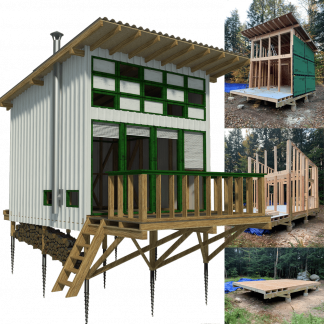A log cabin has a charm that feels endless. It is warm, natural, and carries that storybook quality everyone loves. But beneath the cozy look lies a home that requires a unique kind of care. Wood breathes, shifts, and reacts to every season, which means it won’t stay in top shape without a little help from you.
Bricks can sit quietly for years, but logs behave more like companions that ask for steady care. Ignore them and you might soon see moisture, pests, or sunlight taking away the beauty that drew you in.
The good news is that caring for a cabin is less about heavy chores and more about keeping simple routines. The real question is, how do you make sure your retreat stays sturdy and full of character for the long run?
6 Ways to Keep Your Log Cabin Clean
1. Inspect and Seal Exterior Logs Regularly
Your cabin’s exterior carries the weight of every storm, season, and sunny afternoon. Walking around your cabin at least once or twice a year helps you spot cracks, splits, or gaps in the wood that may allow water or pests to sneak in. These small flaws often grow into costly problems if ignored.
Once inspected, sealing is the next step. A good quality sealant or wood stain creates a barrier against moisture while offering UV protection for logs that face constant sunlight. The south-facing side often needs more attention because it weathers faster. Corners, doors, and windows are also areas where water likes to linger.
Before sealing, always clean the logs. Dirt and debris prevent the product from working as it should. A soft brush and garden hose are safe choices, while pressure washing can be too aggressive. Think of sealing as a routine checkup that keeps your cabin sturdy and beautiful.
2. Schedule Seasonal Deep Cleaning
Even when a log cabin looks freshly swept, fine dust often lingers on log walls, beams, and tucked-away corners. A seasonal deep clean helps clear out these hidden layers, improving air quality while keeping the wood’s finish intact.
Ceiling fans, vents, and light fixtures usually collect the most buildup, so giving them attention prevents dust from spreading back into the room. Using a soft cloth with an eco-friendly wood cleaner on the walls also keeps their surface smooth and preserves the natural shine.
For cabins with high ceilings or large interiors, some jobs are better handled by professionals. Many homeowners turn to house cleaners in Denver for seasonal cleaning support, especially when dealing with delicate log surfaces that need extra care. Their expertise makes it easier to maintain a cabin’s character without risking damage to the wood.
3. Keep the Exterior Free of Dirt and Debris
The outside of a log cabin tells its own story, but it also takes the brunt of everything nature throws at it. Rain splashes mud onto the walls, pollen drifts with the wind, and moss slowly creeps into shaded corners. Left alone, these layers can trap moisture against the wood and open the door to mold and rot.
That is why an annual wash with a mild cleaner and low-pressure water works wonders for protecting the surface.
Cleaning is only half the battle. Shrubs brushing against the walls or tree branches hanging overhead keep dampness close to the cabin. Cutting them back by at least five feet gives the logs breathing room and helps airflow keep the surface dry.
If the logs have not been treated with stain or preservative, products such as OxiClean or Trisodium Phosphate can be applied with a sponge or brush. Rinse thoroughly afterward. When water beads up on the surface, it is a good sign that your logs are still properly sealed.
4. Manage Indoor Humidity to Prevent Mold and Mildew
High humidity seeps into wood, leaving behind musty odors and the perfect environment for mold. A dehumidifier during sticky summer months helps keep moisture levels steady between 35 and 50 percent, protecting both the wood and your indoor comfort.
Ventilation is another hidden hero. Kitchens, bathrooms, and basements often collect steam and condensation, so exhaust fans should run often enough to move damp air outside. Even a small box fan placed near a wall can improve circulation and give the logs a chance to stay dry.
Windows are useful indicators. If condensation gathers on the glass, it usually means the humidity is too high. Regularly checking damp-prone spots such as attics or crawlspaces also prevents mold from growing where it is hardest to spot. With steady airflow, you can nearly double the lifespan of a wood cabin.
5. Protect Against Pests and Insects
Cabin walls are more inviting than you might think, not just to people but to pests that love damp or untreated wood. Termites, carpenter ants, and beetles can quietly hollow out logs until the damage is hard to ignore. Spotting trails of sawdust or tiny holes early is the simplest way to stay ahead of them.
Instead of waiting for a problem to appear, you can take preventive steps. Treatments made with borates soak into the wood and create an invisible barrier that insects avoid. This keeps the structure safe without changing the look or feel of the logs.
Simple habits also go a long way. Gaps around windows or foundations should be sealed tightly, and firewood needs to be stacked well away from the cabin. Closing off gaps and removing nearby food sources makes your cabin less attractive to insects.
6. Maintain the Roof, Gutters, and Drainage Systems
After a storm, small details on a cabin roof can make a big difference. A missing shingle, a loose piece of flashing, or a minor leak might not stand out right away, but they give water an easy path into the logs. Checking the roof regularly, especially after heavy weather, prevents those hidden issues from turning into bigger problems.
Gutters need the same level of attention. When they fill with pine needles and leaves, water spills directly onto the walls instead of draining away. Cleaning them twice a year keeps the flow steady and protects the wood from unnecessary moisture.
The ground surrounding the cabin plays an equally important role. Soil should slope away from the foundation to stop water from pooling near the base of the logs. Good drainage above and below ensures moisture has no chance to linger, where it can cause damage.
Conclusion
Weather, pests, and time all test the strength of a log cabin, but steady care prevents those challenges from taking hold. Regular sealing, exterior washing, and proper airflow work together to preserve both durability and charm. Each step may seem simple, but consistency is what keeps a cabin standing proudly through the years.
With the right attention, the reward is lasting comfort. The wood keeps its glow, the walls stay firm through every season, and the cabin remains a place worth passing down. Longevity comes from effort, and the result is a home that never loses its character.








